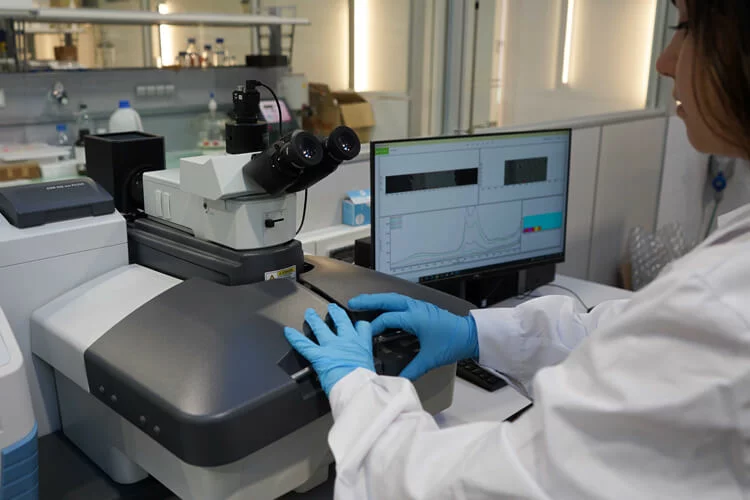IQS has a RAMAN DRX2 Microscope instrument for material characterization. This technique makes it possible to obtain information on the chemical composition of organic and inorganic compounds in any material condition and even in aqueous solutions.

DRX2 RAMAN Microscope at IQS
Raman spectroscopy is named after its discoverer, Chandrasekhara Venkata Raman, the 1930 Nobel Prize in Chemistry winner. In 1928, Raman discovered the effect produced by a transparent liquid irradiated with monochrome light by observing the frequency variations produced in the spectra of the scattered light of the irradiation. It is a light dispersion phenomenon, more specifically the inelastic dispersion of a photon, that gives rise to a high-resolution technique that provides chemical and structural information on any organic or inorganic compound in just a few seconds.
When a monochromatic light is applied to a material, the material absorbs a part of the light and returns the other part, obtaining an elastic dispersion, or Rayleigh, and another inelastic dispersion, or Raman effect. The frequencies at which the latter dispersion occurs are determined and different for each molecule of the material under study. Thus associated with each particular molecule, these frequencies make it possible to identify and distinguish the materials in a specific manner, allowing them to be analysed directly without prior preparation and in a non-destructive way.
The Nanotechnology and Advanced Materials Unit within the Process Transfer and Integrative Technology Centre (CTPTI) at IQS has a DRX2 Raman Microscope instrument (Thermo Fisher) for material characterization. Unlike other techniques such as X-ray diffraction, the Raman technique makes it possible to obtain information on the chemical composition of organic and inorganic compounds no matter what the material’s condition. In addition, the fact that it features a coupled microscope makes it possible to obtain images with composition maps.
Raman spectroscopy applications
The applications of this analytical technique are quite numerous and useful for many sectors of activity, particularly in the identification of drugs and carbon nanomaterials. As water does not interfere with the Raman spectrum, these analyses can be performed directly in aqueous solutions.
The following applications in different industrial sectors are worth highlighting:
-Chemical Industry. With Raman spectroscopy, the shape and structure of polymers can be determined, enabling the molecular identification of materials to identify impurities or a mixture’s components, for example.
Another application in this sector is controlling crystallization and the measurement and orientation of molecules in polymers.
-Identification of drugs. Applications in this field are crucial in many of the pharmaceutical product design and production stages, such as large-scale manufacturing process oversight and control or profiling the distribution of pharmaceutical ingredients and excipients at different formulation cycle stages.
Raman spectroscopy offers incomparable material discrimination, is capable of studying liquid and solid samples, and can be combined with other techniques as it involves a non-destructive analysis. In the world of pharmacology, Raman makes it possible to determine and analyse the composition of drugs to ensure the highest quality, stability, and bioavailability as well as the characterization of medicines.
-Research and development of nanomaterials, especially carbon derivatives such as graphene, carbon nanotubes, fullerenes, or diamond-type compounds. These compounds do not have characteristic bands in the IR spectrum, yet they do in Raman. Therefore, it is the only analytical technique that makes it possible to identify them and evaluate their quality.
-In Biomedicine and Biology, Raman spectroscopy is used in a multitude of medical fields since it enables distinguishing between cancerous, precancerous, and healthy tissues in addition to sensitivity to changes in cell metabolism and protein structures.
-Another field of application of Raman spectroscopy is the identification of pictorial materials in works of art, making it possible to identify the materials used in works of art, such as the pigments, in addition to enabling them to be placed and dated over time.










